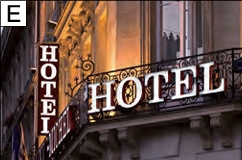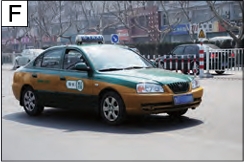热身 Warm-up
给下面的词语选择对应的图片 Match the pictures with the words/phrases.






① fēijī 飞机 ________
② chūzūchē 出租车 ________
③ dàxué 大学 ________
④ fàndiàn 饭店 ________
⑤ tīng 听 ________
⑥ kāi chē 开车 ________
课文 Text
1 在餐桌旁 At the dining table 
A:Nǐ hé Lǐ xiǎojiě shì shénme shíhou rènshi de? 你和李小姐是什么时候认识的?
B:Wǒmen shì 2011 nián 9 yuè rènshi de. 我们是2011年9月认识的。
A:Nǐmen zài nǎr rènshi de? 你们在哪儿认识的?
B:Wǒmen shì zài xuéxiào rènshi de,tā shì wǒ dàxué tóngxué. 我们是在学校认识的,她是我大学同学。
English Version
A: When did you and Miss Li first meet?
B: We met in September, 2011.
A: Where did you meet each other?
B: We met in our university. She was my classmate.
New Words
1. 认识 rènshi v. to meet, to know
2. 年 nián n. year
3. 大学 dàxué n. college, university
2 在饭店门口 Outside a hotel 15 – 2

Nǐmen shì zěnme lái fàndiàn de?
A: 你们 是 怎么 来 饭店 的?
Wǒmen shì zuò chūzūchē lái de.
B: 我们 是 坐 出租车 来 的。
Lǐ xiānsheng ne?
A: 李 先生 呢?
Tā shì hé péngyou yìqǐ kāi chē lái de.
B: 他是和 朋友 一起 开车 来 的。
English Version
A: How did you come here?
B: We came by taxi.
A: What about Mr. Li?
B: He drove here with his friend.
New Words
4. 饭店 fàndiàn n. hotel, restaurant
5. 出租车 chūzūchē n. taxi, cab
*6. 一起 yìqǐ adv. together
3 在公司 In the company 15 – 3

Hěn gāoxìng rènshi nín! Lǐ xiǎojiě.
A: 很 高兴 认识 您! 李小姐。
Rènshi nǐ wǒ yě hěn gāoxìng!
B: 认识 你 我 也 很 高兴!
Tīng Zhāng xiānsheng shuō, nín shì zuò
A: 听 张 先生 说, 您是 坐
fēijī lái Běijīng de?
飞机 来 北京 的?
Shì de.
B: 是的。
English Version
A: Nice to meet you, Miss Li.
B: Nice to meet you too.
A: Mr. Zhang said you came to Beijing by plane, didn’t you?
B: Yes, I did.
New Words
7. 高兴 gāoxìng adj. glad, happy
8. 听 tīng v. to listen
9. 飞机 fēijī n. airplane
注释 1 “是……的” 句:强调时间、地点、方式
Notes
The Structure “是……的”: used to emphasize time, place or manner
在已经知道事情发生的情况下,可以用 “是……的” 强调事情发生的时间、地点、方式等。肯定句和疑问句中的 “是” 字可以省略,否定句中不能省略。
When the occurrence of something is known, “是……的” can be used to emphasize when, where and in which manner it occurred. “是” can be omitted in positive and interrogative sentences, but not in negative sentences.
| Subject | 是 | Time/Place/Manner | Verb | 的 |
|---|---|---|---|---|
| 我 | 是 | 昨天 | 来 | 的。 |
| 这 | 是 | 在北京 | 买 | 的。 |
| 你们 | 是 | 怎么 | 来饭店 | 的? |
否定形式:The negative form:
| Subject | 不 | 是 | Time/Place/Manner | Verb | 的 |
|---|---|---|---|---|---|
| 我 | 不 | 是 | 昨天 | 来 | 的。 |
| 这 | 不 | 是 | 在北京 | 买 | 的。 |
| 我们 | 不 | 是 | 坐出租车 | 来 | 的。 |
2 日期的表达(2):年、月、日/号、星期
Expression of a Date (2): year, month, date, day of the week
汉语中日期的写法和读法都是从大到小。年要分别读出每个数字,再加上 “年”;月、日要读出整个数字,再加上 “月”、“日/号” 。星期的读法是 “星期” 加上数字。如 “2008年8月8号,星期五” 读法是 “èr líng líng bā nián bā yuè bā hào, xīngqí wǔ” 。
Chinese dates are written and read from the bigger unit to the smaller. A year is read digit by digit, followed by the character “年”. A month or date is read the whole number followed by “月” and “日/号” respectively. A day of the week is expressed by the word “星期” plus a specific number. For example, “August 8th of 2008, Friday” is read as “èr líng líng bā nián bā yuè bā hào, xīngqí wǔ”.
(1)明天是2014年5月11号。
(2)A:今天几号?星期几?
B:今天9月10号,星期三。
(3)我们是2011年9月认识的。

Comments